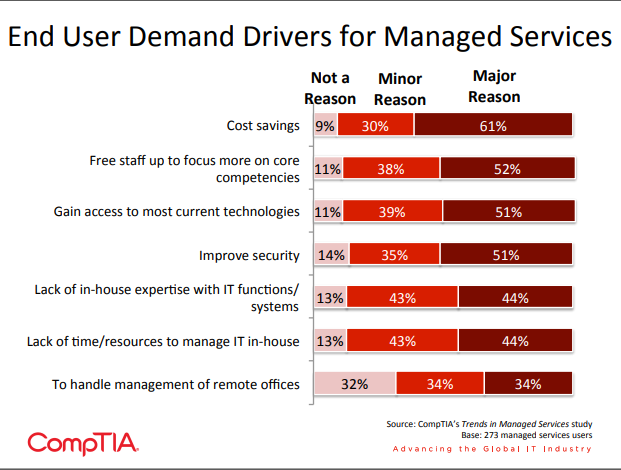What are Managed IT Services?

What are Managed IT Services?
Raise your hands if you’re still depending on your in-house team to handle the maintenance and upgrades of your IT systems. How’s that working out for you so far?
Are your systems being maintained to the best of their abilities? Is your team able to juggle IT maintenance while still focusing on the day-to-day aspects of the business?
If these questions resonate with you, it may be a sign that your business needs an upgrade. And not just any upgrade – but a strategic shift towards managed IT services. A rapidly evolving business landscape requires tools and strategies that can keep up.
No wonder managed IT services are seeing a surge in demand. Research highlights that 45% of businesses are planning to partner with managed security services.
| “The future belongs to businesses that prioritize IT efficiency, and Managed IT services are the cornerstone of that evolution.” says Jason Sondhi, CEO of Sondhi Solutions |
It’s a clear testament to the challenges of managing an IT infrastructure, especially for small and medium-sized businesses that may be resource-strapped.
So, what are managed IT services? How do they fit into the broader puzzle of business efficiency and growth? Dive into this blog as we uncover the managed IT services definition, explore how these services function, and lay out the compelling benefits they offer.
Understanding Managed IT Services Definition
A Managed Service Provider (MSP) is made up of a team of experts who diligently manage, monitor and optimize your IT infrastructure.
They proactively handle any issues that arise, fine-tune your systems, and ensure everything is running smoothly under a predictable monthly fee model.
With managed IT services by your side, your business can accelerate towards success, feeling assured in the knowledge that your technology services are in the hands of seasoned professionals.
Need Comprehensive Managed IT Services?With over 14+ years in the industry, we know what your business needs. |
How Managed Services Work
Now that we know what are managed IT services, let’s understand how managed services work. A managed IT services provider takes on the responsibility of overseeing various IT functions and tasks for businesses.
Managed services include remote monitoring and management (RMM) of servers, networks, and devices to ensure smooth operations and timely troubleshooting. The provider may also handle software updates, security patches, data backups, and disaster recovery plans.
Managed IT services are often governed by service level objectives (SLOs). These objectives set clear benchmarks for performance, response times, and overall service standards. SLOs focus on measurable outcomes and the results the provider aims to achieve. This ensures businesses get a clear picture of the expected service quality and the value they can derive from partnering with the provider.
Types of Managed IT Services
Managed IT services cover a wide array of services to cater to different business needs. Some common service offerings include:
- Technical Support: A dedicated team of information technology experts provides prompt technical support to resolve issues and address user queries.
- Infrastructure Management: MSPs handle the configuration, optimization, and maintenance of the IT infrastructure, including servers, networks, and storage solutions.
- Cloud Services: Managed IT services often include cloud computing and other cloud services, allowing businesses to scale resources and access data from anywhere securely.
- Remote Monitoring and Management (RMM): Through RMM tools, MSPs can monitor networks and devices remotely, enabling proactive identification and resolution of potential problems.
- Disaster Recovery Plan: MSPs develop and execute comprehensive disaster recovery plans to minimize business disruptions during unforeseen events.
- Managed Security: A focus on security services to protect businesses from threats like malware, ransomware, and data breaches.
Tired of Long Wait Times for IT Support?Get a response in just 14.86 minutes on average! |
Benefits of Managed IT Services
Both small and medium-sized businesses can immensely benefit from managed services. Here are some significant advantages:
1. Cost-effectiveness
Managed IT services allow businesses to access professional IT expertise and support without the need to hire an in-house IT team. This shifts from the break-fix model and provides a predictable monthly fee payment model.
As per a survey conducted by CompTIA, approximately half of the companies that partnered with an MSP managed to reduce their annual IT expenses. Out of these, 33% saved between 25-49%, and 13% achieved substantial savings exceeding 50%.
2. Enhanced Security
With cyber threats on the rise, managed security becomes crucial. Studies show that hacker attacks occur approximately every 39 seconds, and an alarming 56% of people lack knowledge about the appropriate steps to follow in case of a data breach.
MSPs offer robust security measures, including the deployment of infrastructure as a service (IaaS), to protect businesses’ sensitive data and critical infrastructure.
3. Focus on Core Competencies
Outsourcing IT management frees up internal resources, enabling businesses to focus on their core competencies. This streamlining of operations enhances overall productivity and efficiency.
More importantly, managed IT services prioritize security, implementing comprehensive measures to safeguard businesses from cyber threats. These include firewalls, data encryption, regular security audits, and proactive threat detection.
A majority of 62% of small and medium-sized businesses lack the necessary in-house expertise to manage cybersecurity.

Source: CompTIA
4. Access to Latest Technologies
Managed service providers stay up-to-date with the latest trends and advancements in IT. Businesses can benefit from cutting-edge technologies and cloud services without investing heavily in research and implementation.
5. Disaster Recovery
60% of small businesses that fall prey to a cyberattack end up closing their doors within 6 months or less. Managed service providers work with businesses to develop and implement robust disaster recovery plans. This ensures that, in the face of unforeseen events, operations can be swiftly restored, minimizing downtime and data loss.
5. Scalability
As businesses expand, their IT needs grow accordingly. managed IT services offer scalable solutions, allowing companies to adjust their resources and services seamlessly as their requirements evolve.

Accelerate Business Growth with Managed Services Expertise from Sondhi Solutions
Navigating the complexities of IT management can be overwhelming, especially when your business requires swift and effective solutions to the inevitable technical hitches.
With 14+ years of experience in the industry, Sondhi Solutions steps in as your steadfast IT partner. With our seasoned expertise, we offer tailored solutions that streamline your operations, reduce downtime, and fortify your systems against security threats.
Have you considered adopting managed IT services for your business? If so, what specific challenges do you hope to overcome, and which benefits are you most excited about?
If not, what factors have held you back from exploring this transformative solution? Share your thoughts in the comments below!
Ready to unlock the full potential of your business with Managed IT Services? Partner with Sondhi Solutions and experience a seamless journey toward growth and stability in the digital world.
